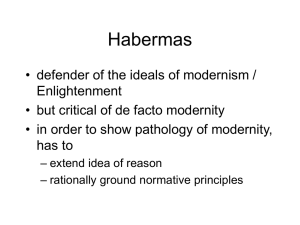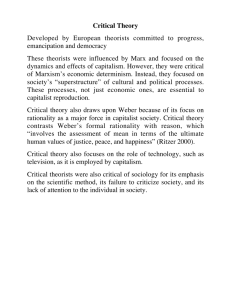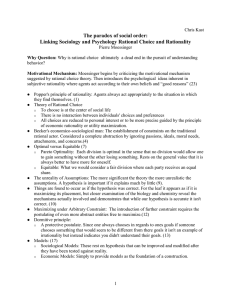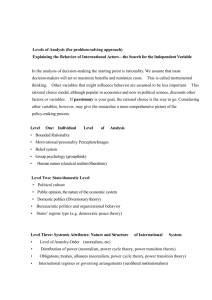1, Winter 2013, pp. 7-24 The Mediation is the Message:
advertisement
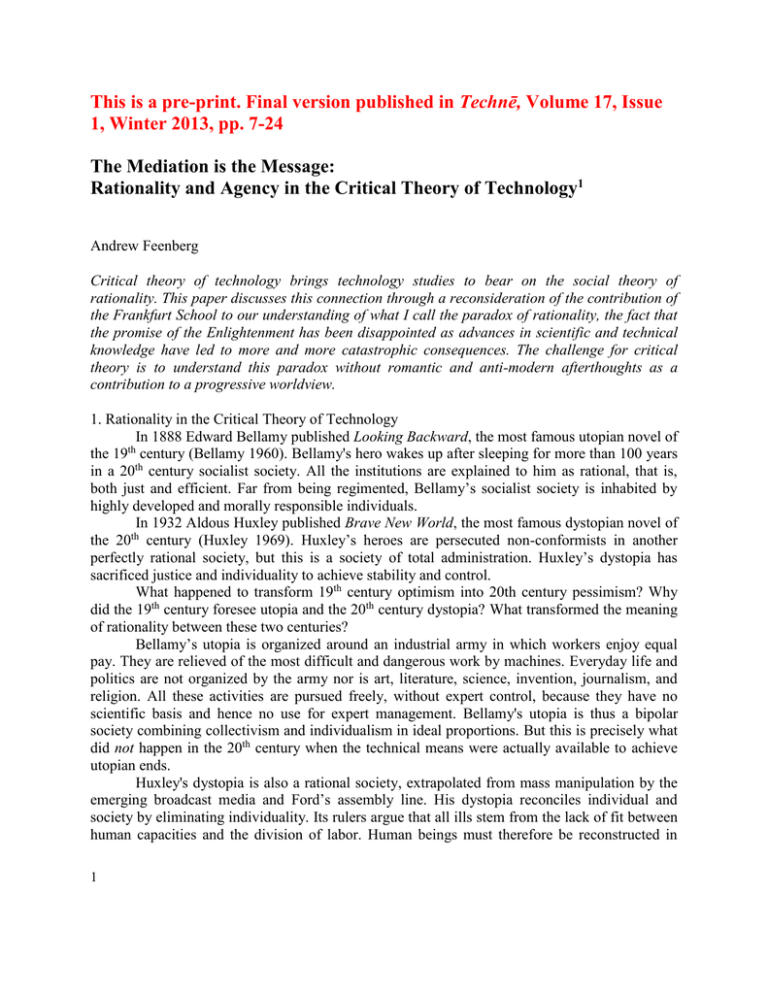
This is a pre-print. Final version published in Technē, Volume 17, Issue 1, Winter 2013, pp. 7-24 The Mediation is the Message: Rationality and Agency in the Critical Theory of Technology1 Andrew Feenberg Critical theory of technology brings technology studies to bear on the social theory of rationality. This paper discusses this connection through a reconsideration of the contribution of the Frankfurt School to our understanding of what I call the paradox of rationality, the fact that the promise of the Enlightenment has been disappointed as advances in scientific and technical knowledge have led to more and more catastrophic consequences. The challenge for critical theory is to understand this paradox without romantic and anti-modern afterthoughts as a contribution to a progressive worldview. 1. Rationality in the Critical Theory of Technology In 1888 Edward Bellamy published Looking Backward, the most famous utopian novel of th the 19 century (Bellamy 1960). Bellamy's hero wakes up after sleeping for more than 100 years in a 20th century socialist society. All the institutions are explained to him as rational, that is, both just and efficient. Far from being regimented, Bellamy’s socialist society is inhabited by highly developed and morally responsible individuals. In 1932 Aldous Huxley published Brave New World, the most famous dystopian novel of the 20th century (Huxley 1969). Huxley’s heroes are persecuted non-conformists in another perfectly rational society, but this is a society of total administration. Huxley’s dystopia has sacrificed justice and individuality to achieve stability and control. What happened to transform 19th century optimism into 20th century pessimism? Why did the 19th century foresee utopia and the 20th century dystopia? What transformed the meaning of rationality between these two centuries? Bellamy’s utopia is organized around an industrial army in which workers enjoy equal pay. They are relieved of the most difficult and dangerous work by machines. Everyday life and politics are not organized by the army nor is art, literature, science, invention, journalism, and religion. All these activities are pursued freely, without expert control, because they have no scientific basis and hence no use for expert management. Bellamy's utopia is thus a bipolar society combining collectivism and individualism in ideal proportions. But this is precisely what did not happen in the 20th century when the technical means were actually available to achieve utopian ends. Huxley's dystopia is also a rational society, extrapolated from mass manipulation by the emerging broadcast media and Ford’s assembly line. His dystopia reconciles individual and society by eliminating individuality. Its rulers argue that all ills stem from the lack of fit between human capacities and the division of labor. Human beings must therefore be reconstructed in 1 mind and body to suit the tasks they are condemned to perform. The alternative the novel proposes, or rather the dilemma it constructs, distinguishes total technology from individualistic chaos, the one offering slavery and stability, the other freedom and catastrophe. Both of these novels concern the radical consequences of social rationalization through technology. The comparison between them raises the question of the significance of rationality. For common sense the rational is universal, necessary and morally neutral. But in the one case technical and moral progress are conjoined while in the other technology is bound up indissolubly with domination. In neither case is rationality the neutral medium in which independent desires and cultural impulses are transparently expressed. On the contrary rationality is desire and culture in living social form. As my title indicates with McLuhan-esque exaggeration, the rational mediation of social action biases the message or meaning of that action. In both novels technology is simply posited in its perfection, leaving no room for posing the question of human agency in the technical sphere. But a new politics is emerging that is neither utopian nor dystopian. This politics responds to the breakdowns of rationality through democratic interventions by ordinary people with consequences for the design of technologies and sociotechnical systems. A new understanding of rationality is needed to respond to the questions raised by this emerging technical politics. My starting point in approaching these daunting issues is the critique of rationality in the Frankfurt School. Theodor Adorno, Max Horkheimer, and Herbert Marcuse argued that rationality is entangled in a paradox in modern times. Progress in technology, that is to say rationality in its most concrete form, leads not to freedom but to domination. The rational control of nature leads to the domination of some human beings by other human beings. The Frankfurt School thus rejected the progressive notion that domination is overcome through progress in rationality. On this view domination should recede as rationalization advances. This is what Habermas calls the Enlightenment project, but it seems to be failing. The failure has led to two critiques of rationality. On the one hand a romantic critique of reason itself calls for a retreat from rationality and all its works. On the other hand various forms of critical theory propose a “rational critique of rationality.” These two styles of critique imply different politics and it is therefore important to distinguish them clearly. The romantic critique of reason as such begins in the late 18th century, accompanied by idealization of the past. In literature the critique opposes passion to bourgeois calculation and social conformism. The familiar image of life versus mechanism captures the essence of the romantic critique. It implies a rejection of modernity. This critique appears to be verified by the 20th century catastrophes of reason. Wars, concentration camps, nuclear weapons, and now environmental crisis threaten the Enlightenment project. But it is difficult to believe that the full content and significance of rationality is exhausted by these disasters. Surely reason has underexploited potentials that can be mobilized in a self-critical approach such as the Frankfurt School’s non-romantic critique of rationality. The Frankfurt School hoped to salvage a coherent basis for a critical theory of modernity out of the flawed inheritance of the Enlightenment and Marxism. There are no ready concepts for talking about the paradox of rationality, the fact that the progress of technology has gone hand-in-hand with the progress of domination. To understand the paradox without romantic subtexts we need a concept of social bias appropriate for the 2 analysis of rational systems. The Frankfurt School intended just such an analysis but failed to develop the categories and methods for performing it. For example, Marcuse followed phenomenology closely in arguing that modern scientific-technical rationality is intrinsically linked to domination and advocated a new science and technology that would treat nature as a subject. But he also rejected any regression to a premodern qualitative method in the study of nature (Marcuse 1964, p. 166). What his reform of science and technology was to entail remains obscure. Critical theory needs a clear and consistent approach to the bias of technology. This is a departure from the usual concept of bias which is closely associated with prejudice and discrimination in social relations. But bias in a less familiar sense appears in other spheres as well. For example, because right handedness is prevalent, many everyday objects are adapted to right-handed use. This too could be called a bias but it does not involve prejudice. Rather it is built into the design of the objects themselves. In this it resembles the kind of bias exhibited by technology and other rational systems. In accordance with this distinction, critical theory of technology identifies two types of bias which I call “substantive” and “formal” bias. Enlightenment critique addresses the more familiar substantive bias. Eighteenth century philosophers were confronted with institutions that claimed legitimacy on the basis of stories about the past and religion. The Enlightenment judged according to facts and arguments and this judgment was fatal to the ancien regime. Much later a similar critique attacked racism and gender bias again in the name of rational ethical principles and scientific knowledge. I call the bias criticized in such cases “substantive” because it is based on pseudo-facts and emotions, specific contents that motivate discrimination. But technology too discriminates between rulers and ruled in technologically mediated institutions. This bias does not involve prejudice. A biased technology is still rational in the sense that it links cause and effect efficiently. Nevertheless, when the division of labor is technologically structured in such a manner as to cause subordinates to perform mechanical and repetitive tasks with no role in managing the larger framework of their work, their subordination is technologically embedded. I call this a “formal” bias because it does not violate the formal norms such as control and efficiency under which technology is developed and employed. In this respect the formal bias of technology is similar to the bias of the market which was the starting point for Marx's critique of capitalism. The market appears rational but, strangely, equal exchange leads to inequality. This inequality escapes Enlightenment critique because it is not justified by narrative myths but by the exchange of equivalents. In the mid-19th century two styles of critique emerged in response, corresponding to substantive and formal bias. The French anarchist philosopher Proudhon famously claimed that property is theft. In his theory, the market is treated as a fraud rather than as a coherent system. Marx was a more rigorous thinker. He realized that the critique of the market would have to begin with the fact of equal exchange rather than denying it. The origin of inequality would have to be found in the very rationality of the market. He proved this with an elaborate economic theory that I will not review here. The problem is not primarily the unfairness of this system, but the larger consequences of capitalist management of the economy, such as the deskilling of work and economic crises. With this argument Marx showed that rational systems can be biased and he extended this type of critique to technology as well. 3 The methodological significance of Marx’s analysis lies in combining the apparently contrary notions of rationality and bias. This was precisely what the Frankfurt School was to do much later in its critique of technology. The point of that critique was not to blame technology for social ills nor to appeal to technological rationality as an antidote to the inefficiency of capitalism, but to show how technology had been adapted in its very structure to an oppressive system. There are two familiar ways in which rational systems and artifacts are biased. In the first place they may require a context for their implementation and that context may have different implications for different individuals or social groups. Consider the case of maps. A map may be an excellent representation of the territory and in that sense highly rational, but it may also be socially biased, for example, in the case of early navigation when map-making was a necessary preliminary to the conquest of territory occupied by natives who themselves had no need of maps to get around. The second way in which rational artifacts are biased is through their design, as in the case of right handed tools or the market in Marx’s theory. Artifacts and systems reflect particular interests through the role of powerful actors in shaping design. This does not make them irrational or inefficient but on the contrary is the way in which they are rational. I employ the concepts of “translation,” “design code” and “representation” to understand this apparent paradox. Technologies are built according to a design code that translates social demands into technical specifications. The sidewalk ramp is a good example. Until it was introduced, disability was a private problem. The interests of the disabled were not represented in the design of sidewalks which obstructed their movements at every crossing. But once society accepted responsibility for the free movement of the disabled, the design of sidewalks translated the new right. This recognition takes the form of a design specification representing the disabled. As technologies develop, their social background is forgotten, covered over by a kind of unconsciousness that makes it seem as though the chosen path of progress was inevitable and necessary all along. This is what gives rise to the illusions of pure rationality. That illusion obscures the imagination of future alternatives by granting existing technology and rationalized social arrangements an appearance of necessity they cannot legitimately claim. Critical theory demystifies this appearance to open up the future. It is neither utopian nor dystopian but situates rationality within the political where its consequences are a challenge to human responsibility.2 2. System and Lifeworld in Instrumentalization Theory In this section I present my own approach, which I call instrumentalization theory, in a critical confrontation with Jürgen Habermas, the most prominent contemporary representative of the Frankfurt School. Habermas introduced communication theory and system theory into Critical Theory and turned it away from the radical critique of modernity toward the reform of the welfare state. He rejected what he considered the anti-modernism of Adorno, Horkheimer and Marcuse. Their critique of social domination was based on a more fundamental critique of the domination of nature but, he argued, the category of domination applies only to human relations. Furthermore, these philosophers never explain the critical standard underlying their argument, nor do they propose a concrete program of reform of modern society. 4 In his 1968 essay on “Technology and Science as Ideology,” Habermas takes up a strand of Marcuse’s argument, the notion that the problem with technology is its universalization as a worldview or ideology influencing every aspect of life in modern society (Habermas 1970). Selfexpanding technology replaces moral considerations and debate. In this idea Habermas finds a way of separating the critique of technology as such, which he rejects, from the critique of the legitimating function of technology in technocratic ideology. Habermas develops his own version of this argument in the course of a critical confrontation with Marxism. Marx argued that the tensions between productive forces and relations of production motivate class struggle, but Habermas claims that class struggle has weakened in intensity to the point where this theory must be completely revised. The tensions Marx addressed through social categories must now be explained through an analysis of the underlying generic action types involved in work and communication. Habermas thus substitutes the concepts of “purposive rational action” and “communicative interaction,” for Marx’s forces and relations of production. Purposive-rational action is success and control oriented. The technical relation to nature is rational in this sense, that is, more or less effective and efficient. It differs from communicative interaction which aims at mutual understanding rather than technical success. The tension between the types of action involved in work and social relations now replaces the original Marxian problematic. Habermas identifies two major features of all societies on the basis of these distinctions. On the one hand every society has an institutional framework based on a system of meanings, practices and expectations established by communicative interaction. On the other hand there are technical subsystems which contain the knowledge, practices, and artifacts that enable the society to produce the goods required for survival. The balance between the technical and communicative dimensions varies, but the institutional framework was always predominant until modern times. Habermas distinguishes two stages in the development of modernity in each of which a different technical subsystem intrudes on the institutional framework. In the first phase of bourgeois society the market penetrates everywhere and displaces the institutional framework as the determining instance of social life. So long as the market is interpreted as a quasi-natural phenomenon, it supports bourgeois hegemony. The legitimacy of the ruling interests is established through their identification with the “laws” of the market. This legitimation fades as governments begin to regulate markets in the 20th century. In the postwar period technology takes over where the market leaves off in organizing more and more of social life; market legitimation gives way to technological legitimation. Legitimation is now achieved by identifying the ruling interests with the efficient functioning of the system. Depoliticization masks continuing domination and justifies a technocratic order. Habermas's early essay is an attempt to establish a critical but positive relationship to modernity. He postulates a double rationalization, both technical and communicative. The technical rationalization is of course familiar but Habermas treats progress in freedom, individuality, and democracy as belonging to a parallel communicative rationalization. He does not criticize modernity as such but rather the over-emphasis on technical rationalization at the expense of communication. Critique should aim at furthering communicative rationalization rather than denouncing technology. 5 In his later work Habermas develops an improved version of his theory. He realizes that individual action orientations do not a society make. The real problem is coordination among many acting subjects. Habermas distinguishes two different types of action coordination characterizing the domains of “lifeworld” and “system.” These now replace the “institutional framework” and “technical subsystem” of his earlier work. In the new theory coordination is achieved differently in each domain, through mutual understanding in the lifeworld and through systems such as the market without much in the way of communicative interaction. The lifeworld is essential to the reproduction of the individuals but it is incapable of managing the institutions of a large-scale modern society. For that purpose more impersonal and quasi-mechanical forms of interaction are required and these are made possible by systems of economic exchange and administration. These systems are self-regulating and require no collective agreement but only stripped-down and conventional responses such as the typical dialogue involved in making a purchase or obeying a command. Modern society depends on the effectiveness of systems at unburdening the lifeworld of excessively complicated tasks. Technocracy is now redefined as “colonization of the lifeworld” by the system (Habermas 1984). The outcome depicted in Brave New World threatens, but unlike Huxley, Habermas does not despair. He advocates increased social control of the system in terms of a consensus reached freely in the public sphere through communicative acts. He thus revives the bipolar vision of Looking Backward. Unfortunately, he abstracts completely from technology in this version of his theory although it has obvious system features.3 Despite this limitation Habermas's dualism has interesting implications. As he argues, modern societies operate in two main worlds, a world of quasi-mechanical or causal institutional interactions and a world structured around meanings and communicative understanding. Each world requires its own method of analysis. But unfortunately there is an ambiguity in Habermas’s application of this dualistic conception. In methodological discussions the distinction is analytic. This means that system and lifeworld co-exist in all social institutions. The weight of the two types of action coordination differs in different institutions, but there is invariably considerable overlap. But it is not easy to apply the colonization thesis on this interpretation since system and lifeworld are always already interpenetrating each other. How then can the one “colonize” the other? Habermas evades this question by tacitly identifying system and lifeworld with separate institutions such as the economy and the family. But this risks neutralizing the system as a sphere of pure rationality. Market rationality, for example, appears to be based on the essence of economic relations rather than on social choices. The market’s boundaries can be set from the outside, but within its range it operates according to its own laws. Similarly, technology can be employed for one or another socially determined purpose but its workings and developmental path are science based rather than socially based. Habermas’s formulation eliminates the problematic of rational domination so central to the thinking of the first generation of the Frankfurt school. He returns to a traditional liberalMarxist notion of progress. Social critique is reduced to boundary policing. Apparently, systems are alright in themselves and the only problem is their extent. Such a view of systems has conservative consequences. The communicative sphere has only an instrumental relation to the separate systems and cannot redesign them from the ground up without violating their internal logic. The system is surrendered to capital and the experts. 6 If Habermas accepts the neutrality of systems, this is because he has no concept of formal bias and hence no conceptual basis for criticizing systems in themselves that does not tip over into romantic rejection. Caught between the neutrality thesis and romantic critique, he is helpless to devise an adequate critical theory of modernity. To escape these problems, it is necessary to stick rigorously to the idea that system and lifeworld are a crosscutting analytic distinction throughout all the institutions of modern society, not social spheres but overlapping perspectives. I therefore propose what I call a double aspect theory of technology and other rational institutions according to which their intrinsic logic is conditioned by the social forces presiding over their design and configuration. The details of this double aspect theory require careful elaboration. Since system and lifeworld are not separate things, but different aspects of one and the same thing, they cannot interact causally. And yet they are not identical either. Analytically distinguished entities such as these entertain logical relationships of some sort. For example, the Pythagorean theorem explains the relations of the three sides of a right triangle. Similarly, the notion of form explains the relations of the parts of a work of art. The related entities—sides, colors, shapes—cannot exist separately and yet they are distinguishable. We grasp them through special concepts adapted to each case. The concept of formal bias serves this function in relation to rational systems, explaining the relation of the analytically distinguished system functions and lifeworld meanings. Hegel wrote a short essay called ”Who Thinks Abstractly” that helps to clarify this (Hegel 1966). He argues for reversing the usual understanding of abstract and concrete. It is not the philosopher who thinks abstractly, but the ordinary person who summarizes a complex of relationships in a single trait. Abstraction is thus a synecdoche in which a part stands for the concrete whole. Hegel gives the example of the servant who is treated as merely a servant by a vulgar master, in contrast with the “French noble” who understands that his servant has ideas and purposes just like himself and who relates to him accordingly as a person. The Habermasian conception of system suggests something similar. Consider market relations. Their communicative simplicity is made possible by abstracting economic exchange from the complex relations that surround it. We enter a store and relate to the clerk exclusively as a clerk, ignoring all other aspects of the clerk’s being. This is abstraction in Hegel’s sense. Systems generally can be considered abstractions from the wider whole of the lifeworld in which they are embedded. What is abstracted is the functional dimension of the lifeworld. I call this approach “instrumentalization theory.” In this theory the causal aspect of the system level is called the “primary instrumentalization” and its social dimension, the “secondary instrumentalization.” As applied to technology the point of the distinction is to show the relation between two fundamental aspects of every functional artifact, causal structure and lifeworldly significance.4 The primary instrumentalization is an imaginative relationship to the technical affordances of natural objects. It “functionalizes” the object. Functionalization involves decontextualizing elements of nature in order to isolate their useful properties. The decontextualization is accompanied by a reduction of the object to just those aspects through which it can be incorporated into a device. Every technical insight involves these operations by which a natural object enters the social world through its practical affordances. The secondary instrumentalization gives the selected affordances meaning in their social context. The reduction of the object, which strips it bare of connections, is compensated too as its 7 design is mediated by ethical and aesthetic values. This is the lifeworldly significance of the technical; it situates artifacts in the way of life to which they belong. Technological design combines both levels seamlessly and both are necessary. Apart from the simplest technical actions, the construction of a device is always a social act involving the secondary instrumentalization. The pattern thereby established is not purely rational because powerful actors preside over the process of accommodation. Some possible designs are favored and others foreclosed with different consequences, beneficial or detrimental, for different social groups. Here is where the formal bias of technology reveals its political significance. The fact that modern societies are able to abstract the functional aspect of artifacts and to construct technical disciplines on that basis masks their essential social dimension. The abstraction certainly has consequences—it makes modern technology possible—but it does not actually eliminate the social. Recall the example of the sidewalk ramp discussed earlier. The ramp’s causal properties are describable on purely technical terms in a specification, but that specification also represents the rights of the disabled technically. That is its significance in the lifeworld. Social criticism must address the design and configuration of technical systems. The instrumentalization theory offers a critical approach to technology without technophobia. It identifies systemic domination with a secondary instrumentalization that narrows the values technologies serve to exclude important contexts and consequences. This is what happened in the development of industrial technology under capitalism. But the secondary instrumentalization may cancel or mitigate the potential for domination by orienting technology toward a broader range of social values. This is the outcome of democratic interventions into technology. Distinguishing these two levels saves the theory from the dilemma of essentialist technophobia vs. the neutrality thesis which threaten it in the various formulations of the Frankfurt School. The key concept missing in all these formulations is the notion of formal bias, which makes possible a true critical theory of technology. Habermas’s colonization thesis can be reconstructed on the terms of this approach. Instead of conceiving system and lifeworld as separate entities in external relationship, they must be conceived as aspects with varying relative weight in particular social spheres and institutions. This requires analyzing systems such as markets and administrations and lifeworld spheres such as the family to take account of the particularities of their specific realizations. For example, the mortgage market depends to a certain extent on a communicative relation of trust but it is far less dependent on communicative action than a family or even a local shop in a stable community. Its system character is predominant. However, at another level, the lifeworld penetrates the structure of the mortgage market qua system, for example, through “redlining” rules that exclude inhabitants of minority neighborhoods from access to loans. This represents the translation of racial inequality into the technical specifications of this particular market. This resembles the bias of technological design discussed above. The design of the mortgage market in this case is formally biased. Generalizing the concept of design bias to markets and administrations exposes them to a much deeper critique than Habermas achieves in the original formulation of the colonization thesis. The potential for the democratization of systems appears at this deeper level. 3. Constructivism, Critical Theory, and Communication 8 The Frankfurt School’s response to the failure of the modern faith in reason was a “dialectic of enlightenment” that recognized the catastrophe of modernity but also the promise of a rational society based on freedom from myth and domination (Horkheimer et al. 202). The most significant application of this dialectic was to the development of mass society. The Frankfurt School’s critique presupposed Kant's ideal of enlightenment formulated in the phrase sapere audi, “dare to know.” This is the ideal of autonomous individuality Marx projected onto the working class as class consciousness. But instead of a self-conscious class, atomized and homogenized masses betrayed Marx’s hope. This is due to the surprising effectiveness of propaganda and advertising which he could not have foreseen. The mobilization of whole populations through consumerism is the new basis of class rule in the mid 20th century. The Frankfurt School argued that the “culture industry” contributed significantly to this outcome. Today’s commodified cultural products are fundamentally different from earlier cultural artifacts, even those sold on markets. Art used to have its own canons and logic based on religious or artistic traditions. The sale of the work did not affect its inner form as profoundly as it does in the case of contemporary commodified cultural products. These products communicate a conformist ideology through stereotyped characters, plots and images. A new authoritarianism emerges in which the only rational response to “reality” appears to be accepting the facts and rewards established by power and reflected by the media. This is the rationalization of consciousness itself. But the counter ideal remains: democratic discussion between free individuals is still an imperative of critical reason. This ideal was concretized sociologically by Habermas. In an early book he argued that the interventions of private persons into public discussion in bourgeois society constituted a new social form, which he called the public sphere (Habermas 1991). The ideal of citizenship as the right to engage in rational discourse concerning the common good emerges from this innovative communicative structure. Habermas’s book concludes on an analysis of the destruction of the bourgeois public sphere by the mass media. Just as participation in the public sphere broadens to include the whole underlying population, it is transformed and instrumentalized by governments and corporations. Habermas’s pessimistic conclusion was relayed by Marcuse’s critique of “onedimensional man” which itself reached a mass audience in the 1960s and ‘70s. So strong is the commitment of most critical theorists to this decline-and-fall schema that they have barely noticed the contrary effect of the Internet. Habermas himself dismissed it—incredibly—in a footnote to a presentation to the International Communication Association (Habermas 2006). This blind spot is rooted in the history of the Frankfurt School. Its thought was elaborated during a long period of defeats for the left. Broadcasting and technical macro-systems offered a dystopian paradigm of technology in this period. There is a large dose of truth in these philosophers’ pessimistic conclusions despite the evident exaggeration. But their critique of technology is limited by this historical context. Today it appears abstract and technophobic and as a result it is frequently dismissed by a younger generation of scholars for whom the Internet is a natural milieu and who are attuned to new forms of struggle and contestation. New struggles around technology cast a different light on the theory of the public sphere. Environmental struggles, user agency on the Internet and in medicine, and economic and technical struggles in developing countries all testify to the fact that the “masses” have not been incorporated completely into the system. These struggles are not always political in a traditional 9 sense but they refute the dystopian tendency of critical theory. Unfortunately, critical theory in both its early formulations and in the recent work of Habermas and his followers ignores agency in the technical sphere. As a result it remains caught in the dystopianism appropriate to the age of broadcasting even as the Internet creates a new social and technical context. For this reason I have turned to social constructivist approaches to technology which do emphasize the role of agency in technical development. The term social constructivism refers to several related approaches in science and technology studies. They have in common a rejection of positivist and determinist theories according to which science and technology are products of pure rational understanding of nature. Constructivists emphasize the social character of science and technology not to the exclusion of rationality but as its context and medium. Although constructivism is not a political theory, it has political implications. Its critique of positivism and determinism undermines technocratic ideology and modernization theory. Placing it in the context of critical theory brings out these political implications. No doubt constructivists were not alone, nor were they the first, in rejecting determinism for more empirically grounded studies of specific technologies. However, their work brought two fundamental methodological principles to the fore: the role of interpretation in design, and the co-construction of artifacts and social groups. The application of these principles to the study of technologies opens up a lifeworld perspective on the material underpinnings of modernity. Let me begin the demonstration of this approach by briefly defining these principles which are applied in the analysis of the Internet that follows. Social constructivist technology studies attempts to identify the “relevant actors” engaged with the design process. These actors define a given state of affairs as a technical problem for which they seek a technical solution. But problem definitions are relative to actors' interests and concerns. A slightly different perspective on the “same” problem may yield a very different technical solution. This is called the “interpretative flexibility” of artifacts. The interpretation of an artifact influences not just its use but also its very design (Pinch et al. 1989). Technology is not simply a matter of artifacts but involves networks of individuals and things co-constructed through various types of associations (Latour 1992). The presence of the network is often obvious, for example, a factory or a hospital, organized around the technologies that mediate the individuals’ activities. In other cases a latent group may be constituted in response to a network’s unintended side-effects or unexplored potentials. This describes, for example, the experience of victims of pollution or unsafe foodstuffs, mobilized once they discover the source of the problems they share. It also describes the experience of users of a technology who introduce innovative features as they discover new ways of exploiting it. But missing in most constructivist accounts are these latent groups, the “irrelevant actors” who lack the power to influence design decisions. This describes the entire underlying population in Marxist accounts of the development of the industrial system and the Frankfurt School’s account of the mass media. The absence of these non-actors from constructivist accounts is problematic (Wyatt 2003). Constructivists have also shied away from invoking diffuse influences such as ideology and culture that play an essential role in politics. Despite its limitations, constructivism is useful for overcoming the complementary limitations of the Frankfurt School. The theories of the decline of the public sphere and onedimensional society reflected the era of television in which broadcasting gained new powers. But 10 the media system has changed radically with the emergence of the Internet and it is therefore necessary to modify the earlier analysis. Constructivist methods make this possible through a much more detailed account of the relations of technical design to social design than the Frankfurt School achieved. If these apparently unrelated approaches can be combined, this is because there is a significant methodological similarity between them. Just as the commodity form enters the content and inner details of the products of the culture industry, so constructivism argues that social demands enter the content and inner details of technical designs. This parallel reflects a similar attempt to get beyond the notion of autonomous fields, neutral in themselves, and merely “used” for extrinsic purposes by social actors. Instead, both critical theorists and constructivists insist on the underdetermination of cultural and technical products and the role of social actors in shaping their inner workings. The history of the Internet reveals the complexity of the relations between technology and politics. Originally called “Arpanet,” it was developed by the Pentagon for timesharing on mainframe computers. The key to its later evolution was the selection of an unusual method for handling data. Telephone companies controlled their networks by managing data flows on central computers. But the Internet protocol required every computer attached to the system to manage its own data. No centralized control over the system was necessary or possible. Frequent user innovation has been an unanticipated consequence of this approach. The Internet went public in the 1980s and the Web made it popular in the 1990s. At this point the scientific model of free information exchange came into conflict with corporate interests, while all sorts of communicative applications developed rapidly on the now public Internet. This multiplicity of actors and their interpretations yields alternative models of the Internet none of which has yet achieved closure. The various interpretations of the Internet reflect ideologies, conceptions of society. The struggle between them implies different social visions, ultimately, different ways of life embodied in design, not simply different uses of the same technology. Three coexisting models of the Internet compete and complement each other today. An information model stems from the original actors in the scientific community. A consumption model responds to the needs of business. A community model introduced by lay users has transformed the Internet into an innovative social phenomenon. If closure around one of these three models is so difficult to achieve, this is largely due to the policy of network neutrality. Under this policy no one type of data can be privileged and given extra bandwidth at the expense of other types. This has prevented powerful actors in business from turning the Internet into another broadcast medium at the expense of its communicative functions (Feenberg 2012). The significance of the community model appears clearly in the light of the Frankfurt school’s critique of the mass media. The essential point of that critique was the effectiveness of broadcasting in commodifying cultural production and delivering a consensus favorable to the ruling interests. The Internet weakens consensus by introducing unconventional viewpoints and making them visible to a large audience at no cost. Commodification may still occur but it is confined to the audience—“eyeballs”—and no longer penetrates the content of the discourse as profoundly as in broadcasting. However imperfectly, the network revives a public sphere of discussion and debate. 11 Technology is not only instrumental to this development, but it plays a central role as an object of discussion in this new public sphere. The Internet connects scattered users and victims of the vast technical systems that underlie modern societies. It thus has a unique and still largely untapped democratic potential to enable latent communities to recognize and articulate their needs. Perhaps the most important manifestation of that potential to date is the defense of the Internet by its own users. Threats to network neutrality have been met by effective mobilization of huge numbers of Internet users. This is democratic intervention for the sake of democratic communication. The democratic applications of the Internet have implications for the theme of rationality and domination. The Frankfurt school demanded that we situate rationality in its social context. It so situated the dominant rationality as exemplified in the bureaucratic and technical systems of advanced capitalism. The politics of the Internet and the agency of users and victims in domains such as environmentalism and medicine signify the existence of another situated rationality, a rationality from below. Foucault's concept of “subjugated knowledge” reflects the experience of those who are poorly represented by the dominant rationality (Foucault 1980). The perspective from below reveals the blind spots of those in charge and inspires resistance where participant interests are slighted by the dominant design. Just as the Frankfurt School related the dominant rationality to a social subject and its project, so must this rationality from below be related to a subject and project. That subject is multiple; it consists in the technical networks that become self-aware and emerge as resistant communities. Where their struggles yield new meanings that feed back into technological development, they affect designs and technical disciplines. In such cases of public action around technological issues, rationality and values come together in the incorporation of interests into revised technical codes. The Internet is an example of the co-construction of technology and society in action. Since it widens the range of communicative features represented by the technical codes I call it “democratic rationalization.” The term is an apparent oxymoron. In Weber rationalization means calculation and control and is implicitly linked to top-down management and administration. Weber assumed uncritically that organization in a modern society requires strict regulation from above. We must generalize beyond Weber’s concept to a view of rationalization that does not prejudge the future. This generalized notion of rationalization would still refer to optimizing means through calculation and innovation but it would not imply a tyrannical system of control. A different type of “rational” society is possible based on mutual discipline and democratic leadership. It would require different technology. This possibility sheds light on the increasingly common interventions from below. These interventions do not usually take the form of electoral politics. Rather, they emerge from controversies, hearings, lawsuits, participation in design, and creative appropriations. They often yield better working systems, for example, in the case of much environmental regulation, or the introduction of communication on computer networks. It is therefore legitimate to call these “rationalizations.” The new politics of technology is gradually introducing technological issues into the public sphere where it is subject to normative considerations. We need a theory of democracy 12 adapted to this evolving situation. The available conceptual framework is the so-called lay-expert dilemma. Experience with the defects and flaws of technological systems motivates public involvement. Lay people speak out and the experts respond. Out of these interactions between lay and expert improved systems may emerge. The technical domain must be redefined to include the experience of users and victims as well as the knowledge of experts.5 Exchanges between them offer two different articulations of the same basic technical phenomena from the standpoints of system and lifeworld. I began by comparing utopian and dystopian images of technology, but in reality we neither seek the one nor flee the other. The threat of technology has diminished with the rise of new social movements that establish the possibility of human agency in the technical sphere. Environmentalism and the Internet have renewed the aspiration to control technology. Although my emphasis here has been on struggles in the technical public sphere, I am aware that they alone cannot decide the issue. The dominant ideology is still dominant but at least its hegemony is no longer uncontroversially secured by reference to the imperatives of technology. The contest engaged around freedom of communication promises further democratic advances. Insofar as success in this struggle is a theoretical task, critical theory still has a contribution to make. References Bellamy, E. 1960. Looking Backward: 2000-1887. New York: Signet. Huxley, A. 1969. Brave New World. New York: Harper and Row. Feenberg, A. 2010. Between Reason and Experience: Essays in Technology and Modernity. Cambridge: MIT Press. Marcuse, Herbert (1964). One-Dimensional Man. Boston: Beacon Press. Feenberg, Andrew, 1999. Questioning Technology. New York: Routledge. Feenberg and N. Friesen, eds. (Re)Inventing the Internet. Sense Publishers, 2012. Feenberg, A. 2002. Transforming Technology. Oxford: Oxford University Press. Foucault, M. 1980. Power/Knowledge, C. Gordon, trans. New York: Pantheon. Habermas, J. 1970. ``Technology and Science as Ideology,`` in Toward a Rational Society, J. Shapiro, trans. Boston: Beacon Press. Habermas, J. 1984. The theory of Communicative Action. Boston: Beacon Press. Habermas, J. 1991. The Structural Transformation of the Public Sphere, T. Burger, trans. Cambridge: MIT Press. Habermas, J. ``Political communication in media society – Does democracy still enjoy an epistemic dimension? The impact of normative theory on empirical research,`` in Communication Theory" vol. 16 (2006) pp. 411-426. Hegel, G.F.W. 1966. ``Who thinks Abstractly,`` W. Kaufmann, ed. and trans. Hegel: Texts and Commentary. Garden City: Anchor Books, pp. 113-118. Horkheimer, M. and T. Adorno. 2002. Dialectic of Enlightenment. G. S. Noerr, ed., E Jephcott, trans., Stanford: Stanford University Press. Latour, B. 1992. "Where Are the Missing Masses? The Sociology of a Few Mundane Artifacts," in W. Bijker, and J. Law, eds., Shaping Technology/Building Society: Studies in Sociotechnical Change. Cambridge: MIT Press. Pinch, T., T. Hughes, and W. Bijker. 1989. The Social Construction of Technological Systems. Cambridge: MIT Press. 13 Wyatt, Sally. 2003. "Non-Users Also Matter: The Construction of Users and Non-Users of the Internet." N. Oudshoorn and T. Pinch, eds. How Users Matter. Cambridge: MIT Press, pp. 67-79. 1 Based on talks given to the Curso, Racionalização, Democrática, Poder e Tecnologia, University of Brasilia, Centro de Desenvolvimento Sustentável, April-May 2010. 2 For further discussion of the forms of bias, see Feenberg, A. 2010. Between Reason and Experience: Essays in Technology and Modernity, Cambridge: MIT Press, chapter 8. For more on this limitation of Habermas’s theory, see Feenberg, A. 1999. Questioning Technology. New York: Routledge, chapter 7. 4 For further explanation, see Feenberg, A. 2002. Transforming Technology. Oxford: Oxford University Press, pp. 175-183. 3 5 In the field of constructivist STS, Brian Wynne and Harry Collins have been especially active in pursuing this approach. 14
